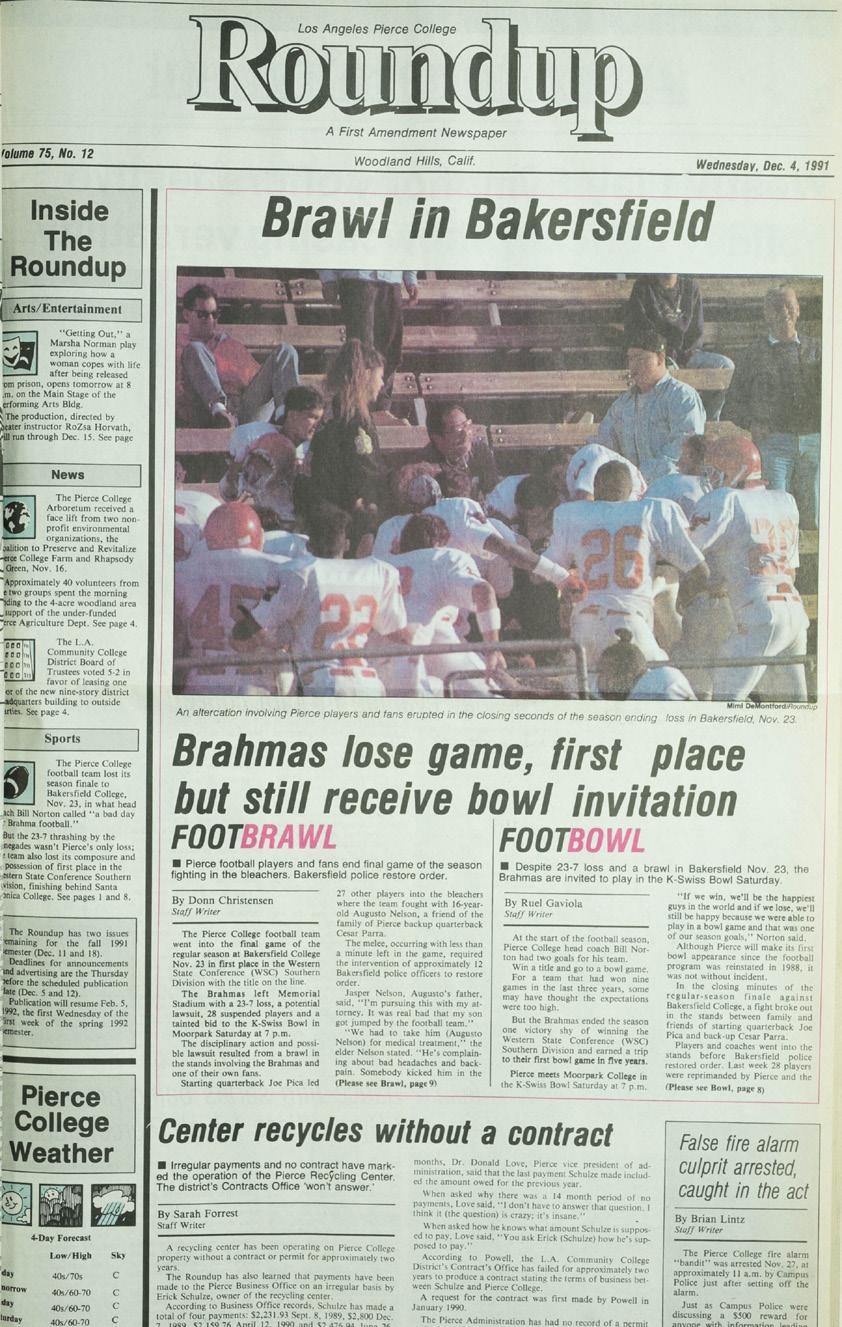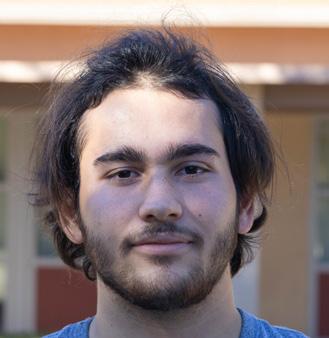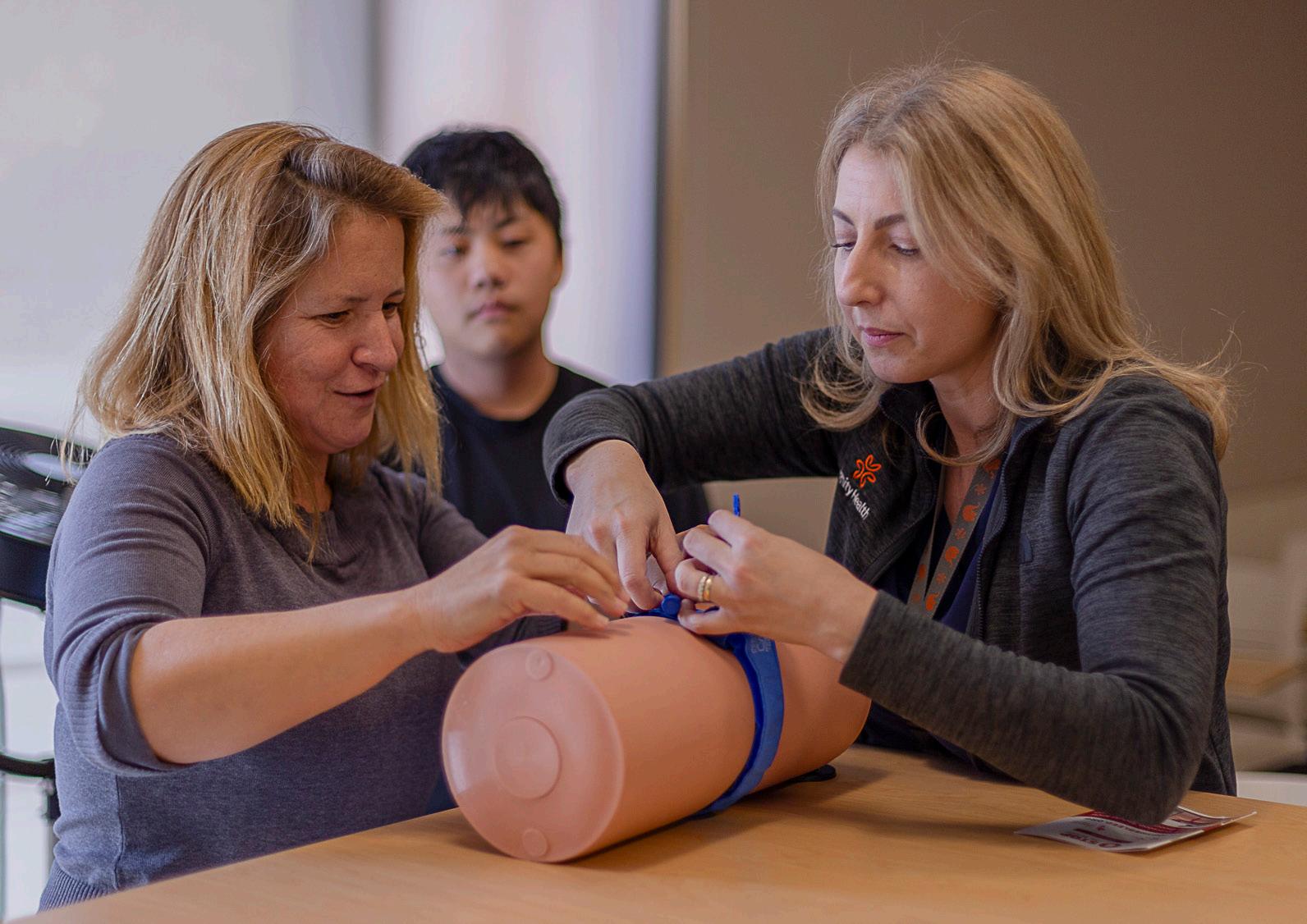
Woodland Hills, California Volume 141 - Issue 13

December 4, 2024


Woodland Hills, California Volume 141 - Issue 13

December 4, 2024
By Nathalie Herrera Reporter
Atable filled with an array of treats accompanied by tables with stamps, stickers and scrapbooking paper to make Christmas cards welcomed Pierce College faculty members as they entered Building 600. on Dec 3.
Pierce held its annual Winter Wonderland for faculty members to participate in the holiday festivities, while also spreading the holiday cheer to others in need.
The Winter Wonderland has been held every year since 2020 on campus by the Events and Recognition Committee. Events
and Recognition Committee
chair Brian Moe explained that this year’s wonderland is different, because the committee added a toy drive for CalWorks students.
“We’re doing a toy drive that is going to help the students who are in our CalWorks program and these students who need assistance to help their kids,” Moe states. “These toys are donated to these students, or parents for them to give their kids a good Christmas.”
According to the County of Los Angeles, the CalWorks program is a 4-year time-limited cash program for families in need, who have children or are expecting children. The program
is a way for student-parents to fund housing, food, utilities and any other necessities.
To get in contact with the CalWork students, the committee worked closely with Pierce counselors. The students were able to provide a wishlist that was shared with Pierce faculty. The list varies for different age ranges in hopes of providing for all CalWork students.
“They did provide a list of sorts, they gave their lists to the counselors and surveyed different age ranges,” Moe said. “We serve such a diverse population so we have toys ranging from zero to teenager.”
While the goal was to provide gifts for students in need during

the holiday season, Student Health Center Director Houry Tanashian shared that these events are also very important in creating a bond for faculty. Tanashian adds that events like the Winter Wonderland are also very important in showing students that the faculty cares for them.
“Events like this that are held for faculty are very important, it is important because since I don’t teach courses specifically I don’t get to see a lot of the faculty,” Tanashian said. “Students will feel supported that we care for them by getting toys for their children, some of them might be having some tough times, but it brings us and the students together.”
Communication Studies
Professor Michelle Brownlee currently serves on the Events and Recognition Committee as well. Brownlee said that a big part of the toy drive is to relieve the financial burden that the CalWorks students experience around the holiday season.
“The financial burden is always an issue for students. We knew we couldn’t necessarily provide something for everyone on campus,” Brownlee said. “We were able to figure out at least a certain group of students that we were able to work with and try and put together something to at least make holidays easier on them.”


6201 Winnetka Ave.
Woodland Hills, CA 91371
Room: Pierce College Village 8211
Phone: (818) 710-4115
Phone: (818) 710-4117
Website: www.theroundupnews.com
Email: newsroom.roundupnews@gmail.com



Editor-in-Chief..............Delilah Brumer
Managing Editor..............Violet Garcia
Photo Editor...................Karla Delgado
News Editor....................Brian Khoury
Campus Life Editor....Gerardo Escobar
Opinion Editor................Daisy Malone
Sports Editor............Abraham Elizalde
Copy Editor............Raquel G. Frohlich
Copy Editor.........Christian Castellanos
Reporters
Nathalie Herrera
Alfonso Vargas
Ryan Kassebaum
Matthew Stewart
Daisy Aguinada
Oscar Silva
Jonathan Wheelock
Erica Logan
Tim Lewis
Photographers
Moses Murga
Angelina Guerrero
Karla Villacorta
Marzia Rankin
Melanie Jurado
Hanna Vandergugten
Victor Montiel
Freedom is a valuable right no country or leader can take away, regardless of race, gender or age. Dec. 10 is Human Rights Day, and it’s an important time to stand up for basic freedoms, which are often overlooked.
Human rights are those given to anyone, regardless of ethnicity, gender, nationality or religious belief. “They are guaranteed the freedom of opinion and expression, the right to work and education, freedom from slavery and torture and the right to life and liberty,” according to the United Nations
Despite there being a physical document listing the 30 Articles of Human Rights, these aren’t always given to everyone in the world. There is a list of countries that are still being deprived of one or more rights that have put them in danger of achieving the freedom that they
rightfully have. This includes Sudan, Yemen, Afghanistan, Egypt, Mauritania, Iran, Russia, Iraq, Algeria, Central African Republic, China and Pakistan. These countries have been restricted from using one or more of their rights due to war, gender inequality, dictatorship, silence and harassment of journalists, land grabbing, lack of resources, political violence and corruption.
Even so, these are only some of the countries that are suffering from the lack of human rights and protection. These countries have declined in human rights, due to the severity of many circumstances, which have increased the chance of fundamental freedoms disappearing. Within the past years, poverty has become one of the indicating factors that have resulted in people dealing with food shortages, housing and
health care. Countries with low income are facing some of the worst crises. The poverty level has reached 9.2% of the global population and they are living on less than $2.15 a day. Yet Article 23 states that everyone has the right to decide on a fair and liveable wage that can help provide food and shelter for their families.
Women and girls are being thrown into unfortunate situations that have led to their lack of opportunity to pursue school, get a job or make personal decisions. But even some countries that are given the rights are also having to deal with them being taken away, because some politicians don’t want to give them full freedom of bodily autonomy, risking their chances of not getting the care they need and deserve. Every day there are people dealing with extreme conditions
On Dec. 4, 1991, The Roundup published Volume 75, Number 12.
Advisers
Jill Connelly
Jeff Favre
Tracie Savage
Morgan Keith
*For advertising, call: (818) 710-2960
Corrections?
Email us at newsroom.roundupnews@ gmail.com
A fight took place in the bleachers of Memorial Stadium between 28 Pierce college football players and a 16-year-old. The Brahmas came into the game in first place in the Western State Conference (WSC), and were playing against Bakersfield. The brawl occurred in the last minute of the game, and had to be split up by 12 Bakersfield police officers. The teenager complained of headaches after the fight. His father said that he would be filing a lawsuit against the team.
Pierce lost 23 to 7, and lost their title for the WSC.
Head coach Bill Norton said that the mash-up was caused because the team had “a bad day.” Both a cheerleader and a wide receiver broke their bones before the fight, and defensive back Bruce Dotson’s family was involved in a crash on the way home.

to survive. Pierce College can help contribute in different ways that can help others be aware of the situations going on in the world.
Dedicating a week in December to human rights, which takes place on Dec.10, is a way to bring more attention and give students, staff or any person interested in making a change the opportunity to donate to organizations that are doing their part to make change happen. Encouraging students to look into human rights movements, vote in elections, stand up for people who deal with discrimination and express their voices for the right reasons, should be one of the college’s focuses.
There is nothing louder than silence when there is a way of making change happen.
on attending, the potential legal consequences, along with the reprimands from the school and police placed the team in lower standing.
The Pierce College Fire Alarm Bandit was finally caught. He was caught on Nov. 27, 1991, at 11 a.m. by the campus police. The police had been discussing the potential $500 reward that would be given to anyone who turned him in, only for them to hear the fire alarm go off for a second time that day.
A recycling center that had been operating at Pierce for more than two years without a contract was looked into by Pierce. The owner of the center had been making irregular payments to the Pierce Business Center, There had been four payments in total, ranging from $2,159.76 to $2,800. Pierce’s Fiscal Administrator Lagrand Powell said that businesses that operate on Pierce require a permit for short-term use or a contract for long term use.

The fight put Pierce’s chance of going to the K-Swiss Bowl at risk. While they still planned
By Christian Castellanos
Copy Editor
With each game of football, the chances of a player getting hurt increases, even as new technology claims to protect against the risk of injury.
Football is not a safe sport, and there should be more protections to ensure the health of players.
A serious issue comes up with any topic of contact sport — head injuries.
A 2023 National Institutes of Health article by Sharon Reynolds said for every additional year spent playing football, there was a 15% increase in being diagnosed with chronic traumatic encephalopathy (CTE), and a 14% increase in developing severe CTE for those with CTE.
Bioethics Project found that CTE can lead to symptoms such as depression, memory loss and an inability to control impulses.
years later after a football player’s career ends. So it is imperative to find ways to address this.
an CBS News interview, sports medicine doctor Marco Alcala said, “‘It’s not the equipment that’s stopping the concussion because these people, they slam into each other, and they still have a concussion,’” and even the best helmet won’t stop the brain from shaking in the skull.
In the same article, CBS News reports two schools where few to no players wear Guardian Caps.
There needs to be more regulations for this kind of discrepancy.
Earlier this year, a joint effort by the NFL and Amazon Web Services (AWS) led to the use of artificial intelligence (AL) and machine learning (ML) to predict and prevent injuries, among other things. The Digital Athlete platform runs “millions

Football League (NFL) reported to have the “fewest number of concussions” in the 2024 preseason. One reason for this: new helmets models that provide the same level of protection as helmets with Guardian Caps, and sometimes even more protection.
Even the newest equipment can’t stop the fact that players are still hitting each other. In
lives.
It’s time to consider new safety measures to protect the players and continue enjoyment of the sport.
By Erica Logan Reporter
Football has been one of America’s most beloved sports and favorite pastimes since the 1950s, whether it is played at a barbeque among friends, or between two professional teams at school or the NFL. A lot of people feel that there should be more rules put in place to protect the players of their beloved American sport, while others think the current rules already in place are “ruining” football as it is.
fans thrive on excitement and the energy from the fast-paced games, and frequent breaks could really dampen this energy from the crowd which could in turn affect the energy of the players and their game.
Football writer Paul Zimmerman has stated, “Nowadays the whole idea is to avoid contact.” This is something that is changing what football is, it is a contact sport. Reducing contact and adding more rules is changing it into something else.

What is your favorite professional

As far as protecting players physically, football players retain long-term brain injuries, break bones or have internal bleeding.
An article from the Football Players Health Study at Harvard University says that one third of former NFL players are believed to have Chronic Traumatic Encephalopathy, which is a brain disease caused by repeated head traumas.
“I’m not really big on sports, but most of the time would be within the cheerleading world. My favorite team within that realm would be a team called Top Gun.”
Sean Ayala - Communications
There are also those who think there should be more physical protection for the players of the sport, and these wants along with the already increased rules and adjustments placed by the NFL, may add to the safety but also may be completely unnecessary. Football is a few things such as the passion, the thrill, the aggression, the competitive nature, the risk, the grit and the ruggedness of the sport. People don’t think of football and think of a sport that would be described as delicate, soft, safe or timid. Yes, football is a very risky and dangerous sport, but that is part of the reason people love it so much. You do not get one rollercoaster because you know with certainty that you won’t fly off.
More rules implemented by the NFL or even in college football can lead to more breaks and pauses during the games. The

The helmets that players wear don’t offer much help.
“The piece of equipment developed to protect the player is instead a fateful hazard, a false sense of security,” according to Tadd Haislop of Sporting News.

The verdict is that while new rules and added protections strive to make the game safer, they often hinder the game’s spirit and thrill. Helmets and padding are meant to reduce certain injuries, but won’t eliminate risks like head trauma or broken bones. There is no need for implementing new rules.

“My favorite professional sports team is the Golden State Warriors because I’m a big basketball fan, and I love Steph.”
Justin Brubaker - Japanese

Maquel Henderson (#9) quarterback rushes to pass the football during a home game against Gledale college on Oct. 19, 2024 at Pierce College Shepard Stadium in Woodland Hills, Calif.
“I like the Los Angeles Lakers basketball team. I’ve been playing and watching people play basketball my whole life. It’s just a cultural thing that we in L.A. always cheer for the hometown team.
Eric Sandoval - Business

“I grew up a Dodger fan even though I lived in Northern California when I was a kid. All I’ve ever done is go to Dodger games and Dodger baseball and this has been the greatest year of my life watching them in the World Series.
Isaiah Magaña - Political science
Interviews by Ryan Kassebaum
by Marzia Rankin
By Jonathan Wheelock Reporter
The Northridge Hospital Medical Center Trauma Team met with Pierce College students and staff for “Stop the Bleed,” an event that covered the basics of stopping life-threatening bleeding after an injury.
The event was held in the Multicultural Center on Nov. 25. Participants in the event earned a certificate showing they completed the training.
“Events like this are very important to the community,” Student Health Center Director Houry Tanashian said. “Because oftentimes, where do emergencies happen? They happen on the streets, on the roads, at home, in at work and there are no doctors and nurses standing around to save those people. So the community people are the first responders.”
The event was held in two sections: a lecture and a handson portion.
The lecture started with Registered Nurse Sarah Bergman explaining the importance of learning these skills.
“Bleeding is actually the most common cause of preventable death after an injury,” said Bergman. “And it has to be stopped right away. Generally an ambulance can take about five to eight minutes in the United States. If somebody is bleeding out, it could actually only take them about three to five minutes to bleed out.”
The two main goals of the event were to help participants
recognize life-threatening bleeding, and to teach how to act and respond to the bleeding.
“The first priority is, when you’re giving medical care to somebody, is to actually protect yourself,” said Bergman.
Once a person ensures their own safety, the first step is to alert 911. The second step is to locate the source of bleeding and evaluate if it is life-threatening.
“Life threatening bleeding is a volume of blood that’s continuous. It’s pulsatile like a sprinkler,” said Bergman. “And sometimes it’s enough to pool in clothing or on the ground.”
Once the bleeding has been identified, the next step is to stop it. Bergman discussed three methods of stopping the bleeding once it starts: compressing the wound, packing the wound and applying a tourniquet.
“To perform [compression],” said Bergman. “You’re actually going to want to use a small amount of gauze or material and you want to have just enough to cover the wound and apply direct pressure on it on the bleeding site. If you put too much material or too much gauze on it, the pressure is less effective.”
Pressure is applied directly to the wound with the whole body.
Packing requires stuffing a deep wound with gauze or material to help prevent bleeding before applying pressure. When packing a wound it is important to be careful of any sharp objects (fragments of glass or bone) that may be inside the wound.
The final method of blood loss prevention covered was the use
of a tourniquet. A tourniquet is a strip of material (usually cloth or fabric) that gets wrapped around a limb tightly in order to prevent blood flow to the limb.
“Tourniquets really should only be considered for extremity bleeding that does not stop with pressure or packing,” said Bergman. “And it’s going to hurt. Tourniquets are very painful. And that person might be really
upset, but you’ve got to let them know it will hurt. It’s an expected thing.”
Participants received a kit to help prevent blood loss after the event.
“It was definitely informative,” said Pierce student Nadim Bouhamdan. “I thought it was really cool that it was free and [that] it was here.”
The class was held twice
in order to accommodate the amount of people who registered.
“I’m really excited that people are actually interested in this because when I was younger, this wasn’t available,” said Bergman. “It makes me hopeful for everybody that they’re interested in stuff like this.”
More information about the program can be found at StopTheBleed.org.

of Registered Nurse Sarah Bergman during the “Stop the Bleed” event in the Multicultural Center at Pierce College in Woodland Hills, Calif., on Nov. 25, 2024.
By Daisy Aguinada Reporter
Financial status and academic updates were the main topics discussed at the last Academic Senate meeting of the fall semester, held in Building 600 on Dec. 2.
Pierce College President Ara Aguiar addressed the college’s financial situation at the beginning of the meeting. The district’s reporting shows a reduction in the estimated deficit from $19 million to $10 million. However, Aguiar highlighted that the college still faces the largest deficit in the district due to its minimal reserve funds.
“We don’t have a reserve,”
Aguiar said. “The small reserve we do have is from years ago, which is about $5 million dollars. The interest that we make on that money goes completely to the farm.”
Aguiar explained the challenges of balancing the budget while maintaining academic offerings.
“We need to stay flat with most of our expenditures and be willing,” Aguiar said.
Academic Senate Secretary Jennifer Moses discussed how the budget constraints can possibly impact Pierce students and class scheduling.
“The two things that will be immediately apparent to students are that there will be no new
hiring of faculty and no increased scheduling of sections,” Moses said. “If students have any challenges in finding open sections of the classes they need, unfortunately, we won’t be able to open or offer new sections.”
Moses explained that offering additional sections won’t be possible at the moment due to the financial restrictions.
“We’re trying not to increase our budgetary expenditures by offering additional classes or hiring new faculty,” Moses said. “So, it will be challenging for students to find available classes.”
Academic Senate President Margarita Pillado discussed ongoing efforts to improve
scheduling strategies.
“We are working on a task force with the administration and department chairs to create more effective scheduling tools,” Pillado said.
This effort is part of the college’s broader goal of improving inter-departmental collaboration and ensuring smooth implementation of transfer pathways.
The college has applied for a $60,000 grant from the Foundation for California Community Colleges to assist with program alignment and guided pathways.
crimes were reported for the week of Nov. 27 to Dec. 3.